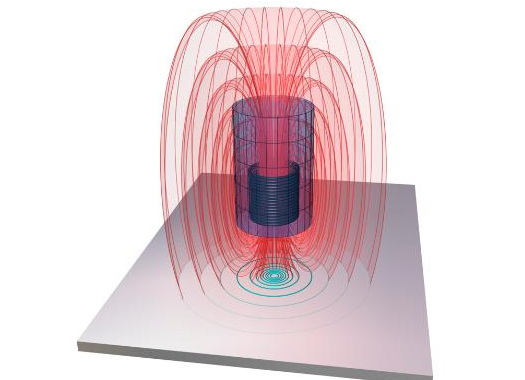How does an eddy current displacement sensor work?
The eddy current measurement principle is a non-contact measurement principle. This type of sensor is particularly suitable for measuring rapid displacement changes without the need to apply an external force on the measured object. Non-contact measurement is of great significance for applications where the measured surface does not allow contact, or applications that require a long life of the sensor.
Strictly speaking, the eddy current measurement principle should belong to an inductive measurement principle. The eddy current effect is derived from the energy of the oscillating circuit. Eddy currents need to be formed in a conductive material. Providing an alternating current to the coil inside the sensor probe can form a magnetic field around the sensor coil. If a conductor is placed in this magnetic field, according to Faraday's law of electromagnetic induction, an eddy current will be excited in the conductor. According to Lenz's law, the magnetic field direction of the eddy current is exactly opposite to the coil magnetic field, which will change the impedance value of the coil in the probe. The change of this impedance value is directly related to the distance between the coil and the measured object. After the sensor probe is connected to the controller, the controller can obtain the variation of the voltage value from the sensor probe and use this as a basis to calculate the corresponding distance value. The eddy current measurement principle can be applied to all conductive materials. Because the eddy current can penetrate the insulator, even if the surface is covered with a metal material of the insulator, it can also be used as the object of the eddy current sensor. The unique coil winding design can meet the requirements of high temperature measurement environment while achieving the extremely compact shape of the sensor.
All German iridium eddy current sensors can withstand measurement environments with dust, humidity, oil and pressure. However, there are some limitations to the use of eddy current sensors. For example, for different applications, the corresponding linearity calibration needs to be done. Moreover, the output signal of the sensor probe will also be affected by the electrical and mechanical properties of the measured object. However, it is these limitations in the use process that make the German iridium eddy current sensor have a resolution of nanometer level. At present, the German iridium eddy current sensor can meet the measurement range of 100μm to 100mm. Depending on the measuring range, the installation space can also range from 2mm to 140mm.
The mechanical engineering without a displacement sensor is almost unimaginable. These displacement sensors are used to control different movements, monitor liquid levels, check product quality and many other applications. Here we talk about the different situations that the sensors may face, the harsh use environment, and how to deal with unfavorable factors. Sensors are often used in very harsh environments, such as oil, hot steam or severely fluctuating temperatures. Some sensors are also used on vibrating parts, in a strong electromagnetic field or need to be a certain distance away from the measured object. For some important applications, requirements for accuracy, temperature stability, resolution, and cutoff frequency are also required. For these limitations, different measurement principles have their own advantages and disadvantages. This also means that there is no uniform way to optimize the measurement principle.

Eddy current sensors can be subdivided into shielded and unshielded two types. With a shielded sensor, a narrower electromagnetic field distribution can be generated without the sensor being affected by the proximity of radioactive metals. For unshielded sensors, electromagnetic lines are emitted from the side of the sensor. The range is often larger. Proper installation is essential for signal quality. Other objects nearby can also affect the signal.
With more than 40 years of experience, German Mi Iridium has continuously innovated to improve the performance of displacement sensors. Continuous progress has been made in R & D, testing, quality control and equipment monitoring.
The eddyNCDT product family can achieve a maximum cut-off frequency of 25 kHz while meeting nano-scale resolution.
A typical application of an eddy current sensor is a fully automatic welding tester. The testing machine is used for quality control of welds. The reason for selecting the eddy current sensor here is that only the sensor based on the eddy current principle can withstand the strong electromagnetic field brought by the welding robot. The measurement should also meet micron-level accuracy and a 4mm range.
If you want to know more, our website has product specifications for sensor, you can go to ALLICDATA ELECTRONICS LIMITED to get more information

